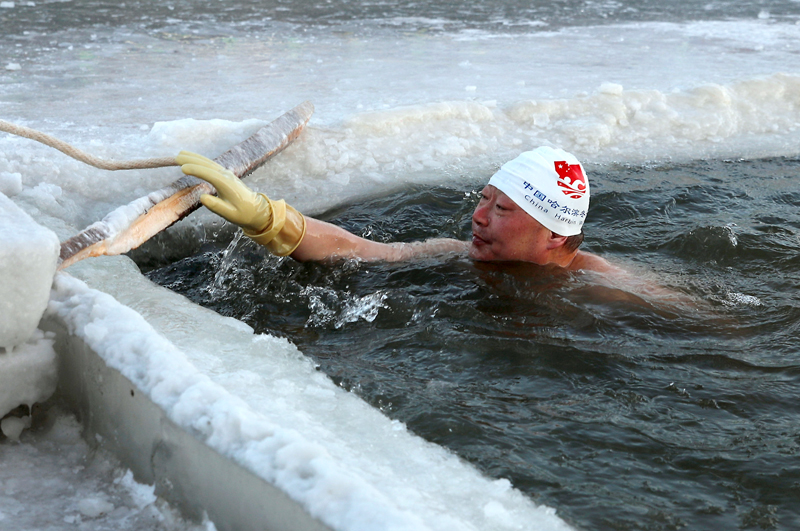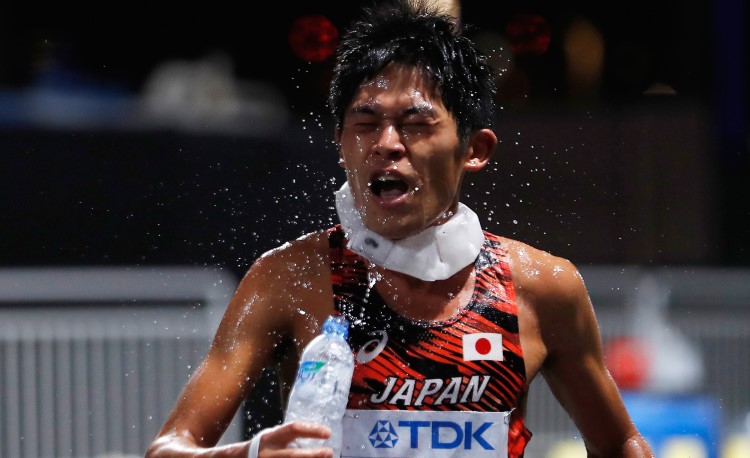Sustained hard exercise in a hot environment presents a greater challenge to the body’s homoeostatic mechanisms than any other situation. The combination of a high rate of metabolic heat production and a restricted capacity for heat dissipation leads to hyperthermia (high body temperature), which may progress to heat illness, inevitably impairing exercise performance.
It has been demonstrated, in sports science labs, that prolonged cycling capacity is lower at 21°C than at 11°C and is even further reduced at 31°C, when VO2max is reduced, heart rate increased and skin and rectal temperature elevated(1). Heart rate rises in an attempt to meet increasing pressures on the blood supply, to increase skin blood flow for cooling purposes and to maintain oxygen supply to the working muscles.
Heat exposure combined with exercise results not just in hyperthermia but also in hypohydration (low fluid levels) if fluid losses are not replaced, and this combination will dramatically reduce exercise capacity. There may be a critical core temperature which is the limiting factor for exercise in the heat.
When exercising in the heat for the first time, many people experience some of the symptoms of heat illnesses, such as heat cramps, fainting and exhaustion. But the good news is that the occurrence and severity of these symptoms can be significantly reduced by a process of acclimatisation, which allows the body to adapt to the stresses of a warm environment gradually, by repeated exposure.
Complete heat acclimatisation requires up to 14 days of exposure, but adaptations occur at varying rates. Even as few as five days of heat exposure will allow some adaptation to increased environmental temperatures(2). Within these five days, control of cardiovascular function improves, plasma volume increases, heart rate drops and blood flow is prioritised to reach active muscles and the skin surface. The increase in plasma volume is temporary, allowing the body to cope with the increased need for cooling by redirecting blood to the skin capillary beds. Taken together, these short-term adaptations lower perception of work rate and allow toleration of the heat prior to longer-lasting changes.
These changes occur over the next week or so. Between days five and eight, the body’s thermoregulatory response improves so that sweat rates increase and sweat production starts earlier, so boosting the dissipation of body heat by evaporative cooling. This process prevents body temperature rising critically and also allows for a reduction in skin blood flow as a means of cooling down core temperature, so increasing the blood available to supply active tissues.
The adaptation environment must match your competition venue
By 10 days of heat exposure, sweat rates can be as much as doubled, although individual responses are as varied as individual sweat rates; (think of how some people are drenched in sweat after an hour’s exercise while others are barely perspiring). Bear in mind, though, that hot dry climates produce different adaptations to sweat glands than hot humid ones, so you need to be sure that the environment you choose for acclimatisation closely matches your competition venue.The early stages of heat acclimatisation see a drop in the loss of sodium chloride (salt) in sweat and urine, resulting in an increased extracellular fluid (ECF) volume. ECF includes the blood plasma, and this process helps the body to maintain a stable core temperature before the later thermoregulatory adaptations occur. ECF and plasma volume return to normal between days 8 and 14(2).
Following heat acclimatisation, the body has improved efficiency and is better equipped to tolerate the demands of exercise. The heat acclimatised athlete is able to exercise with a lower skin and core temperature and heart rate than an unacclimatised person. Since it is widely believed that a critical core temperature may be linked to a drop in exercise intensity, or even a complete termination of exercise, you can see how improving thermoregulatory mechanisms improves exercise tolerance. Additionally, muscle glycogen utilisation is reduced and post-exercise lactate concentration is lower (2).
Although excess fluid and salt intake will not enhance acclimatisation, dehydration or salt deficits will hamper the body’s ability to respond to the heat stimulus, so it is important to maintain an adequate fluid intake during heat acclimatisation. Many studies have shown that dehydration markedly impairs exercise performance and recovery, so it follows that adequate hydration is crucial to a successful adaptation to heat.
Your ability to acclimatise is linked to your current level of fitness. A high VO2max (>60ml.kg-1.min-1), for example, may enhance your ability to acclimatise and the speed at which you reach a stable acclimatised state. This may be because physiological adaptations to heat are similar to those experienced during hard training in a cool environment. Thus, for well-trained individuals, some of the adaptations – such as increased plasma volume, increased sensitivity of the sweat response and production of more dilute sweat – are already in place.
Passive heat exposure produces the same adaptations, and thus people who have lived in a warm climate all their lives have advantages denied to those from cooler climes. If you are gradually acclimatising during a period of warm weather training, around 10 consecutive days of exercise are required, with 2-4 hours of heat exposure each day. The first two days should involve only light exercise lasting about 15-20 minutes, with a gradual build-up of duration and intensity.
For optimal acclimatisation, 24-hour exposure to the relevant environmental conditions is better than training in the heat, then resting in an air-conditioned room for the rest of the day. Some high-intensity exercise should be performed in the same heat and humidity as expected for the race, but only after 4-5 days of low-intensity exercise. This protocol combines both passive and active heat exposure to maximise adaptation without causing heat illness.
It is possible to assist the acclimatisation process by exercising in a heat chamber for 1-3 hours per day before departure, but this will be only partially effective and should be seen as an adjunct, rather than a replacement, for full acclimatisation. Wearing impermeable clothing while exercising may also make a small contribution to the acclimatisation process.
Many laboratory studies examining the benefits of acclimatisation, using heat chambers alone, have reported improved cardiovascular adaptations. One such study, involving 100 minutes of treadmill walking in a heated chamber for nine consecutive days, showed a decrease in rectal temperature and heart rate and a rise in sweat loss over the study period(3).
Full acclimatisation is not always possible for athletes because of the time requirement. And sometimes there is no time at all to acclimatise – such as on those rare occasions in the UK when temperatures suddenly soar. In such cases, you may need to take some short-term measures, such as pre-cooling, to prevent your performance being impaired by the heat.
Pre-cooling is a strategy that helps to prevent excessive overheating during exercise by reducing body temperature beforehand (4). This introduces an increased margin for metabolic heat production, increasing the time in which you can exercise in comfort and safety. Pre-cooling has been shown in many studies to have a favourable effect on endurance exercise in hot environments(5). It has been suggested that, as well as increasing time to fatigue, this process also enables athletes to pick up their pace towards the end of an event(6).
Pre-cooling can be achieved either by cold air exposure or cold water immersion. The former is not a practical option – unless you have access to a sports science lab or a large freezer. However, cold water immersion can be achieved simply by standing under a cold shower or filling a bath with water and ice. If taking the bath option, water should be gradually cooled, if possible, to avoid acute cold stress, with temperature starting at around 29°C and gradually reducing by no more than 2°C every 10 minutes for a total of about 60 minutes.
As well as being easier to organise than cold air exposure, cold water immersion also permits a greater rate of heat loss from the skin, a more uniform decrease in skin temperature and a greater reduction in core temperature(4).
Fluid intake plays a vital role in the ability to tolerate the heat, and is the most practical intervention strategy for coping with exercise in the heat. Acclimatisation will actually increase fluid needs because of increased sweat rates. By ensuring you replace these lost fluids, plasma volume can be maintained, allowing circulation and sweating to continue and making it easier for you to maintain exercise intensity and duration for longer.
Fluid replacement is top priority
Since carbohydrate oxidation is reduced during exercise in the heat, fluid ingestion is geared more to maintaining hydration than to carbohydrate replacement. A large volume of diluted fluid (around 2% carbohydrate) has been shown to be more beneficial in the heat, with increased time to exhaustion for endurance exercise, than no drink or a high-carbohydrate (15%) drink(7).Even plain water is beneficial for maintaining plasma volume, but the addition of a small amount of salt will increase the volume of water ingested that remains in your body, which is especially important when sweat rates and electrolyte losses are high. A third of a teaspoon of table salt in a litre of water should be enough to improve water retention.
Given the large body of evidence relating dehydration to reduced performance during exercise in the heat, fluid replacement should be top of your list of priorities when preparing for warm weather competition. Prior hydration is also an important factor because if you are dehydrated before exercise begins, the reductions in your performance will be greatly magnified. Again, a dilute carbohydrate drink including a small amount of salt will suffice.
In conclusion, the successful competitor will have prepared for the heat with a strategy that includes acclimatisation, pre-cooling and hydration. The different elements involved in this process must be carefully planned and fitted to your schedule, with pre-cooling performed in the hours before the competition and hydration maintained throughout your training and race preparation. If practised and followed, these coping strategies should place you well ahead of the pack in terms of your ability to cope with the heat.
Clare Miller
References
- Medicine and Science in Sports and Exercise, vol 29, (9), p1240-1249, 1997
- Encyclopaedia of Sports Medicine and Science, Internet Society for Sport Science, 1998.
- Fed Proc, vol 22, p704, 1963
- British Journal of Sports Medicine, vol 36, p89-94, 2002
- Journal of Sports Sciences, vol 17, p937-944, 1999
- Journal of Applied Physiology, vol 79, p1971-1976, 1996
- Journal of Sports Sciences, vol 18, (5), p339-351, 2000










